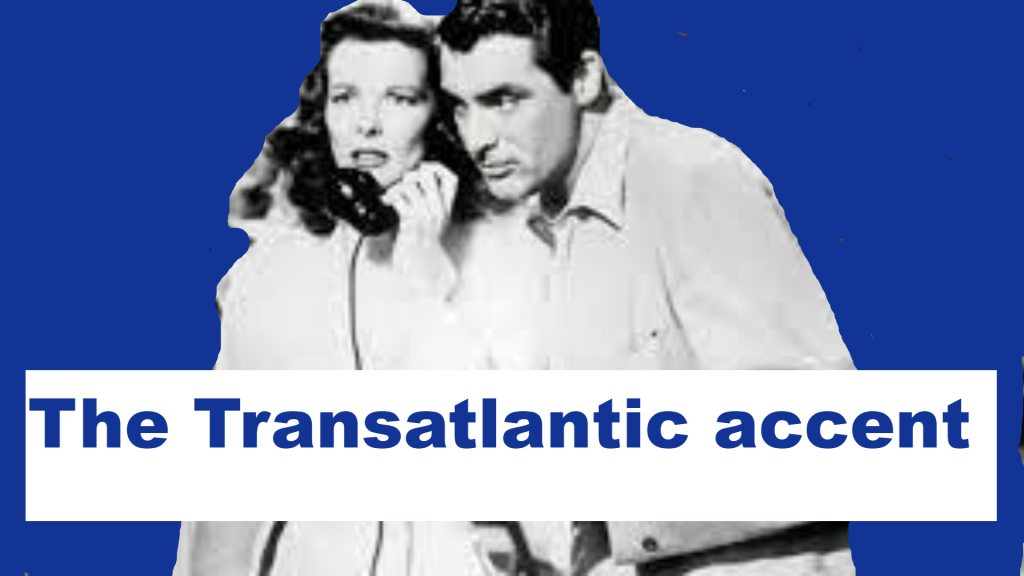The transatlantic accent, sometimes called the transatalantics accent, blends elements of American and British English. People don’t naturally speak this way; they learn it through extensive practice. This transatalantics accent often signals that someone is sophisticated or well-mannered. It’s commonly heard in classic Hollywood films. Many actors, including Katharine Hepburn, Cary Grant, and Bette Davis, used this accent in movies like Casablanca and Bringing Up Baby. The transatalantics accent is known for its clear and precise sound, becoming a symbol of wealth and style in films from the 1930s to the 1950s.
- Transatlantic Accent Overview
- Unique Features of the Transatlantic Accent
- Why It Sounds Unique
- History and Influence
- FAQs
Transatlantic Accent Overview
Definition
The transatlantic accent is also called the mid-atlantic accent or transatalantics accent. It mixes parts of American and British English. People do not speak this way naturally. They have to learn it on purpose. Linguists say it is a hybrid that is taught. No place in the world speaks like this without training. People must practice a lot to use this accent. One thing that makes it special is non-rhoticity. This means people do not say the ‘r’ sound after vowels. For example, “winter” sounds like “wintah.” The mid-atlantic accent uses broad ‘a’ sounds. These are like the British way of saying “father” or “path.” People who use this accent say consonants very clearly. The ‘t’ sound is extra sharp. The accent has its own way of stressing words. This is different from both American and British English. Teachers made the transatlantic accent to sound neutral or international. People often think this accent sounds fancy and clear.
Note: The transatalantics accent is not a natural dialect. It was made to connect American and British English. It helps speech sound clear and polished.
Origins
The transatlantic accent started in the late Victorian period. At that time, more people moved between Britain and the United States. This made new ways of speaking appear. Travel and communication got better with steamships and telegraphs. People and ideas crossed the Atlantic faster. The mid-atlantic accent grew from this mix. Elocution schools on the East Coast of the United States helped a lot. They taught the transatalantics accent to students in private schools and drama classes. The goal was to help students sound fancy and upper-class. The accent became a sign of high social status. Actors in early Hollywood movies often used it. The transatlantic accent did not become common for everyone. Only people with special lessons learned it. Over time, the accent became linked to being stylish and important, especially in theater and film.
Unique Features of the Transatlantic Accent
The transatlantic accent is special because it mixes American and British English. Its features make it sound smooth, musical, and different from other accents. The mid-atlantic accent was made to sound fancy and easy to understand. Many people still think it is interesting today. Here are the main things that make this accent different.
Pronunciation
The transatlantic accent has some clear traits that make it easy to spot.
- People do not say the ‘r’ sound after vowels. For example, “winter” sounds like “wintah.” This is called non-rhotic pronunciation.
- The accent uses wide ‘a’ sounds. Words like “path” and “can’t” sound like “pahth” and “cahnt.”
- Some words use British ways of saying them. For example, “schedule” is said “SHED-yool” and “tomato” is “toe-MAH-toe.”
- People say consonants very clearly. The ‘t’ sound is sharp and easy to hear. For example, “water” has a strong ‘t’ sound.
- The way words are stressed can change. For example, “address” is stressed at the start (AD-dress), and “advertisement” is said “ad-VERT-is-ment.”
These things make the transatlantic accent sound fancy and dramatic. It mixes the best parts of American and British English.
Intonation
The way people speak with this accent makes it sound musical and fancy.
- The accent has a more even rhythm than most American accents.
- People use a big rise and fall in their voice. This makes the accent sound lively and musical.
- This is not like the flat way people talk in regular American English.
- The mid-atlantic accent often ends sentences with a small rise in pitch. This makes it sound a bit more stylish.
Experts say that the way people use their voice and vowels helps make the accent sound musical. These things, along with careful word choices, make the accent sound upper-class and dramatic. Where and how people learn it, like in school or on the radio, also makes it seem fancy.
Vowel Sounds
Vowel sounds are a big part of the transatlantic accent.
- The accent uses low, open ‘ah’ vowel sounds, like in British Received Pronunciation.
- Words like “dance” and “class” sound like “dahnce” and “clahss.”
- Here are some examples:
- “Martha, I want to go to dance class” sounds like “Martha, I wahnt to go to dahnce clahss.”
- “I enjoy classical masterpieces” becomes “I enjoy clahssical mahstahpieces.”
- “A tisket, a tasket, I love my yellow basket” is said “A tisket, a tahsket, I love my yellow bahsket.”
- Famous actors, like Katharine Hepburn, used these vowel sounds in old movies. In “A Philadelphia Story,” you can hear her use the open ‘ah’ vowels.
These main features—non-rhotic pronunciation, clear speech, and soft, long vowels—work together to make the transatlantic accent unique. The mix of American and British styles, plus its musical and fancy sound, help the mid-atlantic accent stand out.
Why It Sounds Unique
Comparison to American and British Accents
The transatlantic accent is special because it is not from one country. It mixes parts of American and British English. This makes it sound both normal and new at the same time. In American accents, people say the ‘r’ at the end of words. British accents usually do not say the ‘r’ sound. The transatlantic accent drops the ‘r’ after vowels, just like British English. So, “car” sounds like “cah.” This way of speaking makes the accent smooth and fancy.
There are other ways the accent is different. The transatlantic accent uses long, open vowel sounds. This is like British Received Pronunciation. Words like “dance” and “glass” sound like “dahnce” and “glahss.” American English uses shorter vowels in these words. The accent also uses a sharp ‘t’ sound, like in British English. So, “better” sounds very clear and crisp.
The transatlantic accent is not fully American or British. It is in the middle, so it is easy to notice.
Cultivated and Artificial Qualities
The transatlantic accent is not natural. People do not speak this way unless they learn it. They often learn it in acting classes or with private teachers. This makes the accent sound neat and a little dramatic.
- No place in the world speaks this accent naturally.
- Top acting schools taught it to sound fancy.
- Famous actors like Cary Grant and Katharine Hepburn learned it by training.
- Some rich Americans used it to show they were important.
- Today, actors still learn it for old movies and plays.
Speech coaches say learning this accent takes practice. Students watch old movies and copy how actors talk. They work on dropping the ‘r’ at the end of words. They also make the ‘t’ sound extra clear. Coaches tell students to talk fast to match the accent’s lively style. Learning the transatlantic accent helps actors sound classy and helps them learn other ways of speaking.
This accent is special because people have to learn it. Its careful style and training make it sound clear, fancy, and classic.
History and Influence
Hollywood and High Society
The transatlantic accent showed class and learning in the early 1900s. From the 1920s to the 1940s, many Hollywood actors learned it. Edith Skinner, a voice coach, helped teach this accent to stars. Movie studios wanted actors to sound fancy and smart. Films from the 1930s to 1950s often used this accent. Famous stars like Katharine Hepburn, Cary Grant, and Bette Davis spoke this way in movies. Franklin D. Roosevelt and Eleanor Roosevelt also used the transatlantic accent. This showed it was linked to rich people and politics.
Rich people in the Northeast learned the accent in private schools. They also learned it in speech classes. Teachers said this accent showed good manners and learning. The accent did not come from any one place. It sounded neutral and classy. It made people seem elegant and important in movies and real life.
The transatlantic accent became a sign of being fancy and good. Many thought it showed someone was smart and polite.
Decline and Modern Relevance
After World War II, the accent started to go away. By the late 1960s and 1970s, movies wanted to feel more real. Directors like John Cassavetes and Francis Ford Coppola picked actors with normal accents. The transatlantic accent started to sound fake in these new films.
Today, people can still learn the accent for acting or voice work. Actors use it for roles set in the early 1900s or when they want to sound formal. Apps and online lessons help students practice the accent. Old movies and radio shows are also good for learning this way of speaking.
The transatlantic accent is still a sign of style and history. It inspires actors and learners who want to sound special.
The transatlantic accent is special because it mixes American and British English. It is easy to understand and does not use the ‘r’ sound after vowels.
- In the past, it showed someone was fancy in movies and rich schools.
- Now, actors use it when they want to sound smart or from another time.
- Many people think it reminds them of old Hollywood and being important.
Experts say the accent’s rare sound and long story make people curious. Today, teachers like many ways of speaking, but the transatlantic accent still interests fans of language and movies.
FAQs
What is the main purpose of the transatlantic accent?
The transatlantic accent helps people sound clear and fancy. Teachers made it for actors, speakers, and students. It does not come from any country. People use it to sound smooth and proper.
Can someone learn the transatlantic accent today?
Yes, people can still learn this accent now. Many acting schools and online classes teach it. Students watch old movies and work with speech coaches. The accent is still helpful for theater and film.
Why did actors in old movies use the transatlantic accent?
Movie studios wanted actors to sound classy and easy to hear. The accent made movies feel stylish and special. Directors thought it made characters seem smart and important.
Does anyone speak with a transatlantic accent naturally?
No one speaks this way without learning it first. People must practice and train to use it. The accent does not come from any place or group. It is always something people learn.
Where can people hear the transatlantic accent today?
People can hear this accent in old movies, radio shows, and some plays. Actors sometimes use it for roles set in the past. People who love language also study it for fun or learning.



